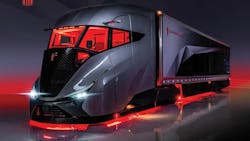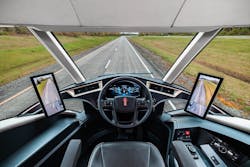Kenworth debuts its SuperTruck 2 demonstration vehicle
LAS VEGAS—Six years in the making, Kenworth debuted its SuperTruck 2 demonstrator vehicle at the ACT Expo. The SuperTruck program, funded by the Department of Energy, awarded $80 million to four Class 8 truck OEMs to “develop and demonstrate cost-effective technologies that more than double the freight efficiency of Class 8 trucks,” according to a DOE statement. Kenworth exceeded the goal: the Kenworth SuperTruck 2 is 136% more efficient than the brand’s baseline model, the 2009 Kenworth T660.
The truck features a futuristic look that resembles a bullet train. It also features a center driving position, and it even has a sleeper compartment, complete with a sofa and a murphy bed that folds down to accommodate long hauls.
While the aesthetics and driver necessities were added to the Kenworth SuperTruck 2, those aspects only came secondary.
“The objective was to increase freight efficiency by over 100% and to increase our engine efficiency to as high as possible,” Joe Adams, Kenworth’s chief engineer, told FleetOwner. “We set ourselves an internal target of 55% [engine efficiency].”
Adams told FleetOwner that the 136% efficiency gain was achieved by improving three aspects of the truck: aerodynamics, powertrain, and weight reduction.
Kenworth’s SuperTruck 2 aerodynamic improvements
It all started with aerodynamics, according to Adams. Improvements that stick out, in particular, are that every wheel is wrapped by the body of the Kenworth SuperTruck2. This required a redesign of multiple components—shrinking the size of the front of the truck and redesigning the axles—to make room for the wheels to turn within the body of the truck. This required moving the engine to below the cab, similar to a cab-over truck.
Further, Kenworth removed the side mirrors entirely and replaced them with cameras. The engineers also added a parabolic, wraparound windshield and enclosed the truck’s steps within the body, much like an RV. This makes the truck's ingress and egress less like climbing a ladder and more like using a staircase.
Starting with aerodynamics to drive the freight efficiency improvements “helped sculpt how we wanted to build and construct the truck from the beginning,” Adams told FleetOwner. It was only after the aerodynamic improvements were decided that the Kenworth team handed the design over to the styling team.
“We let our styling guys play second fiddle to our aerodynamicists, and so it's a little bit of a reversal from what we've done and prior progress,” Adams said. “It was really cool to do that, and then the result is fantastic.”
Kenworth’s SuperTruck 2 powertrain
The Kenworth SuperTruck 2 still runs on diesel fuel, powered by the Paccar MX-11 engine, but it features a “mild” hybrid configuration with a 48-volt electric generator and lithium-ion batteries. The batteries are recharged through regeneration and power electric fans, electric steering, and power for electric coolant and HVAC pumps.
“We're taking the accessories related to mechanical loads off the engine and replacing them with an electric configuration and then creating the electric energy to power them,” Adams explained.
Kenworth also replaced a traditional HVAC system with a heat pump with an electric motor. This resulted in a 60% efficiency increase from the traditional air compressor system. The SuperTruck 2 also features a grid heater and aftertreatment system. “All told, we achieved a 55.7% engine efficiency with this design,” Adams said.
“Today’s modern diesel engine demonstrates around 47% efficiency,” Maarten Meijer, PACCAR’s senior engineering manager for advanced technology, said in a statement. “Reaching 55.7% was a major step forward and could only be done by applying new technologies that had not been explored until today.”
See also: SuperTrucks' lessons and real-world trucks
Kenworth’s SuperTruck 2 weight reduction
“With a composite cab structure that we have, redesigning the front end suspension, redesigning crossmembers, we’re able to take almost 4,000 lb. out of the truck,” Adams told FleetOwner. But Kenworth measures its SuperTruck’s weight reduction in combination with the trailer as well. Kenworth partnered with a trailer company that made lightweight panels and additional modifications to decrease the trailer weight by 3,000 lb.
Adams said that’s a weight savings that can go straight toward the bottom line, either by carrying more cargo or by reaping the fuel economy benefits of that weight savings.
From project to production
While the SuperTruck 2 might appear to be a truck fit for the future or a science project that will never make it out in the field, Adams said the Kenworth engineering team has already implemented aspects from the SuperTruck 2 into production today.
In Europe, trucks are being produced without side mirrors, replacing them with cameras. Kenworth T680s in North America also have the same camera system, but because of laws, the mirrors remain, although smaller than the side mirrors of previous generations of T680s.
“That's one of the things that as we were developing this product, we went ahead and said, ‘Hey, this is something that we think is really a great feature to offer our customers,’” Adams told FleetOwner. “So, we put that in production last year.”
Other features of the Kenworth SuperTruck 2 that might eventually make it to production include the mild hybrid system, Adams said, as powertrain innovations with the SuperTruck program are “certainly an opportunity for us to leverage and learn.”
See also: SuperTruck 2 tech to benefit ZEVs: NACFE report
Kenworth is the fifth OEM to debut its truck, as Volvo, International, Freightliner, and Peterbilt have already shown their trucks to the public.
About the Author
Jade Brasher
Senior Editor Jade Brasher has covered vocational trucking and fleets since 2018. A graduate of The University of Alabama with a degree in journalism, Jade enjoys telling stories about the people behind the wheel and the intricate processes of the ever-evolving trucking industry.



